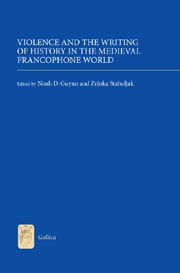Book contents
- Frontmatter
- Contents
- List of Illustrations
- List of Contributors
- Acknowledgments
- Introduction
- 1 Historicity, Violence, and the Medieval Francophone World: Mémoire Hystérisée
- Part I Theorizing Violence
- Part II Institutions and Subversions
- 4 Vice, Tyranny, Violence, and the Usurpation of Flanders (1071) in Flemish Historiography from 1093 to 1294
- 5 Marvelous Feats: Humor, Trickery, and Violence in the History of the Counts of Guines and Lords of Ardres of Lambert of Ardres
- 6 Dismembered Borders and Treasonous Bodies in Anglo-Norman Historiography
- 7 The Good, the Bad, and the Beautiful: Violence in the Canso de la Crozada
- Part III Gender and Sexuality
- Part IV Trauma, Memory, and Healing
- Index
- Already Published
6 - Dismembered Borders and Treasonous Bodies in Anglo-Norman Historiography
from Part II - Institutions and Subversions
Published online by Cambridge University Press: 05 April 2013
- Frontmatter
- Contents
- List of Illustrations
- List of Contributors
- Acknowledgments
- Introduction
- 1 Historicity, Violence, and the Medieval Francophone World: Mémoire Hystérisée
- Part I Theorizing Violence
- Part II Institutions and Subversions
- 4 Vice, Tyranny, Violence, and the Usurpation of Flanders (1071) in Flemish Historiography from 1093 to 1294
- 5 Marvelous Feats: Humor, Trickery, and Violence in the History of the Counts of Guines and Lords of Ardres of Lambert of Ardres
- 6 Dismembered Borders and Treasonous Bodies in Anglo-Norman Historiography
- 7 The Good, the Bad, and the Beautiful: Violence in the Canso de la Crozada
- Part III Gender and Sexuality
- Part IV Trauma, Memory, and Healing
- Index
- Already Published
Summary
From 1272 to 1307, Edward I wielded the power of the English monarchy and a formidable bureaucracy against a seemingly endless list of enemies domestic, foreign, and merely adjacent. The innovations in legal theory and practice that took place during his reign were numerous, but concurrent with the processes of legal systemization and standardization there were rampant abuses and glaring exceptions. One of those exceptions was treason, an act of war punished as a capital crime and manufactured as a series of spectacles anticipating its legal definition. Those judged guilty of treason were subjected to extreme punishments applied in new combinations and sequences: they were dragged on the ground to the place of execution before being subjected to ritual punishments, including hanging, dismemberment, and various combinations of beheading, disembowelment, castration, and burning. Among other aims, such elaborate executions were staged to be interpreted. That is, execution represented an attempt by the monarchy to shape the context and reception of the dismembered and disseminated body, particularly those of Welsh and Scottish insurgents who rebelled against English rule. Confronted by the dismembered quarters of treasonous bodies, some contemporary chroniclers described those partial bodies as texts to be read exegetically, corroborating the moralizing, tropological narrative shaped by king and court, a narrative in which punishment responds to crime.
- Type
- Chapter
- Information
- Publisher: Boydell & BrewerPrint publication year: 2013



